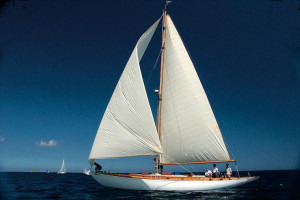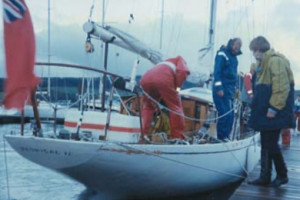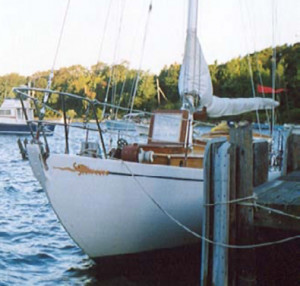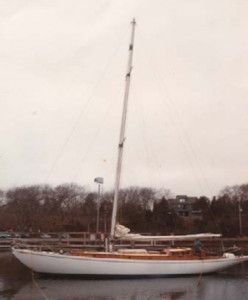The boat was a beauty, but she let in a lot of water…
By Ian Galletti
Having crewed on a Contessa 32 when she was harmlessly ‘pooped’ many times during the 1979 Fastnet storm, I couldn’t understand why a past generation of yachtsman dreaded the experience.
However, I was soon to learn why when I delivered Madrigal II across the north Atlantic, from west to east during October 1990.
Madrigal II is a beautiful 48-foot William Fife (1857-1944) classic, with long overhangs (LWL 33’2”), narrow beam (10’6”) and low freeboard, rebuilt in 1951 by the Fairlie Yacht Slip Ltd (successors to William Fife & Son).
She had been completed in 1934 but her hull was rebuilt in the 1950s, after the original had rotted whilst stored during the war years.
Now she was in reasonably good condition, according to the surveyor’s report, except for “softness in mahogany planking at the fore end of the waterline. Repairs will obviously be required here. However, in order to make a Transatlantic crossing we would recommend local refastening of the affected planks forward and fitting of
a large copper or lead ‘tingle’ over the affected area.”
The ex-owner was not concerned, and nor was I when I examined the boat later. nevertheless, I should have been warned by the sentence in the letter he wrote to me before we met:
“You might want extra fuel because you will be pumping every watch.”
The extra fuel was to keep the batteries charged enough to provide power for the electric bilge pump.
When I asked him to explain, he replied with a cryptic: “You’ll see! But I’d advise you to cover all the cockpit vents.” I took his advice and had the vents sealed with plywood and caulking, but it was almost impossible to waterproof the cockpit locker doors.
We departed Quisset harbour, near Woods Hole, towards the Cape Cod Canal in thick fog and light winds on the evening of October 8.
We left the Cape Cod Canal five hours later for the 20-day crossing to the Clyde, but it was not until the wind picked up that we understood the comment about pumping.
I had ordered that the bilges be pumped every hour on the hour. To conserve fuel, the pumping was to be done manually unless the engine was running, and the number of pump strokes was to be recorded in the log.
Pumping involved lifting a floorboard at the foot of the companionway, kneeling by the hole in the sole and stretching down about 18 inches into the deep bilge, to reach the pump handle.
Resting one’s forehead, or cheek, on the sole helped to relieve the strain on one’s back.
In zero wind and flat sea conditions, the number of pump strokes each hour was negligible (about seven). In a Force 3 with a slight sea it became around 25 strokes an hour – but just after midday on Friday 26 we recorded a maximum of 504 strokes an hour.
This was after an estimated NW Force 7/8 had been blowing for 15 hours, creating a rough quartering sea.
The total number of strokes recorded for the delivery, mostly in NW winds of Force 5 to 6, was 43,010 – an average of 1,792 a day or 75 an hour and we were using the electric pump whenever the engine was running. The engine, a Perkins 4107, was used for 102 hours.
When the pumping rate was around 400 strokes an hour, for hours on end, I was reminded of the late Peter Haward’s tale of Wensley’s Wave.
This yarn was recounted in All Seasons’ Yachtsman published by Adlard Coles in 1961 (and later as All Weather Yachtsman): “Janabel is a fine modern yacht, but her cockpit is only of the semi-watertight variety. Portions of Atlantic which settled in it pursued two different courses:
“Part went directly back via the cockpit drains, while the rest cascaded via the locker doors into the bilge, there to be pumped out by handdraulics.”
Madrigal II was similar, despite our efforts to seal the ventilation louvres in the cockpit. She also leaked through every hatch, and this made her remarkably wet down below as she punched her way through the heavy seas.
However, unlike Janabel, Madrigal was fitted with an autopilot, so the person on watch could easily cope with the pumping routine themselves without having to disturb any of the off-watch crew.
In November l990, just after our return, Yachting Monthly published Transatlantic with Sumurun by Robert Fannin. He reported: “Sumurun was designed and built in 1914 for Lord Sackville of Kent by William Fife – the most sought-after designer of his day. He created boats of fine sheer with long overhangs and a very graceful appearance.
“Sumurun can be a very wet boat when plunging into head seas. The entire tops of waves are shipped aboard whole and then cascade down the deck like a band of Hell’s Angels.”
Sumurun is 94-foot overall so you can imagine the effect on a similar yacht of half her size. The amazing thing was that the water was remarkably warm, once we had entered the Gulf Stream.
The warmth of the waves breaking into the cockpit was a welcome relief, for the deck watch, from the biting NW winds! Furthermore, on the calmer days it was a pleasure to be able to take a cockpit bucket shower using the warm seawater.
Tribute is due to the crew who pumped their way across the Atlantic with me. The mate was Alan Thomas, coxswain of the Tenby lifeboat, had won a Silver Award for a courageous rescue involving two embayed trawlers and was keen to get back in time to receive his Macmillan’s Man of the Year award.
The hands were Bill Lowry and Sue Carter. Bill was an old friend and navigator colleague, from RAF days, whose wife thought that a north Atlantic crossing in mid-winter might dampen the ardour of his dreams of extended cruising. Sue was a wannabe delivery skipper whose ambition was sponsored by an enterprise training scheme office in Bristol.
For the first four-day shakedown period, we used a staggered double Swedish watch of four hours on and four hours off during the night and six on, six off during the day.
Later we changed to a three on, six off plus mother system. in the true traditions of the sea, Bill, as the novice, became the permanent “mother” or galley slave and was always on call.
However, by October 22, after serving many excellent meals and generally looking after us and doing the odd maintenance job exceedingly well, Bill had had enough of mothering.
I happily granted his request to be included on the deck watch roster and appointed myself as non-watchkeeping skipper.
This let the others get on with it while I navigated and did the odd chore. Later, out of boredom, I put myself back on watch.
We used a rotating “three on six off plus mother” with the person coming off at midnight becoming mother until 0600 hours the following morning. The turn as mother was looked forward to as a day off – and a welcome break from pumping.
The three on, six off watch meant, because there were only four usable berths (out of six), that the deck watches needed to hot bunk – to avoid disturbing either the sleeping watches or mother (who had a bunk of his/her own). We were all delighted when it was our turn to use Sue’s berth.
In the first first few days, when we had all slept in our own berths and before mine, and the spare, had become waterlogged, Sue had created a cosy waterproof nest.
She had skilfully draped tarpaulins around hers so it had remained dry, whereas the men had not bothered, with the result that their bedding became sodden from the water leaking through the saloon hatch/skylight.
This was most unfair to Sue but it did mean that we were getting six hours more-or-less-undisturbed rest periods.
For the last two days, to cope with heavy weather (Force 7 to 9), we reverted to a two-person on watch Swedish system. Thus Sue recovered her berth at the end.
So that we could each have our own berth for the duration, I had originally planned to sleep in one of the two quarter berths in the pilothouse.
However, it soon became obvious that they were both uninhabitable.
Gallons of water poured through the main hatch like a mini Niagara Falls, even after we had completely sealed it (or so we thought) with caulking. (This meant we had to crawl through the opening for the rest of the trip).
The other ‘leakproof ’ deck hatches and skylights were not much better. The staggered joints, baffles and associated scuppers – excellent examples of the shipwright’s art, might have been water-resistant in the Clyde but they simply could not cope with the solid green seas of the Atlantic.
Such green water has been estimated to exert a pressure of about two tons per square foot. This pressure is more than enough to penetrate any gaps, of which Madrigal had many, in the hull or superstructure of a yacht. So, the soft planks in the hull proved to be the least of our water ingress problems!
The delivery was not quite the wet hell that this report might suggest. There were many good bits: like the flocks of birds that accompanied us throughout – day and night. So those survival books which say that “the appearance of birds suggest that land is near” are quite wrong.
Then there was the school of killer whales which joined us at 51º55n 21º20W on the evening of the 16th day out. I just could not imagine such beautiful and apparently friendly creatures being any sort of a threat to a yacht – as has been reported by others.
Above all, for me, there was the wonderful feeling of camaraderie that is often generated when people suffer a shared misery while working towards a common goal.
Ian Galletti, has wide experience of both racing and cruising and has numerous tales to tell of adventures from the time he spent as a delivery skipper. Main Photo: Early days and time for a wash on deck.






